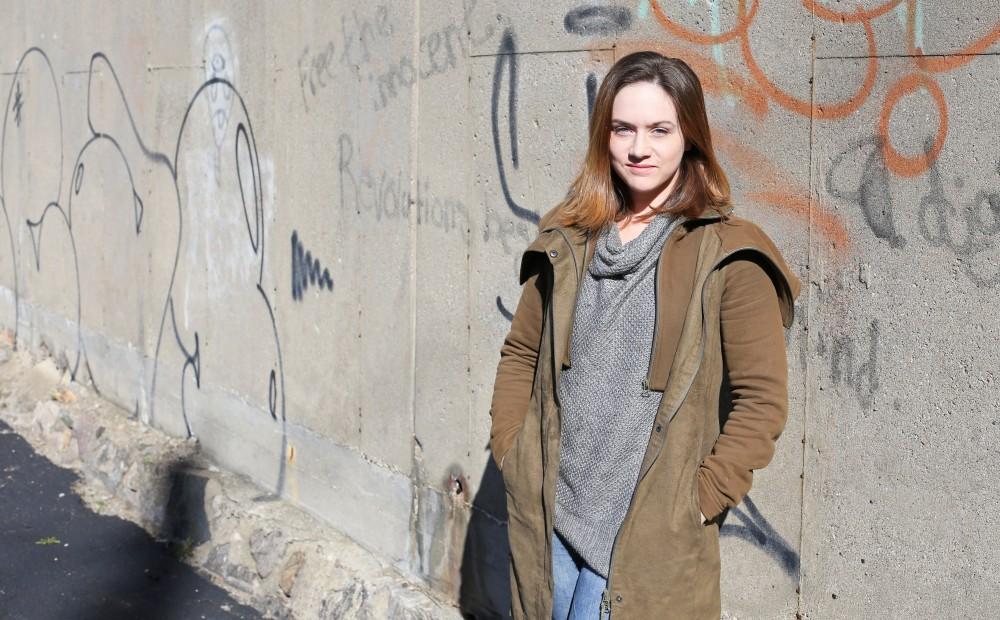Geograffiti

Oct 27, 2014
Alyson Mabie has been interested in graffiti since she was a child. Since enrolling as a geography major at Grand Valley State University, she has taken this interest to the next level by using it as the foundation for her research.
On Oct. 17, Mabie’s work won her a competition at the annual meeting of the East Lakes and West Lakes Divisions of the Association of American Geographers, which was hosted by the department of geography at Western Michigan University. Mabie’s paper, “Claiming Turf: The Spatial Distribution of Three Discrete Types of Graffiti/Street Art in Southeast Grand Rapids, Michigan,” offers insight into the nature of graffiti in mid-size cities.
“I wanted to understand the differences in gang and non-gang graffiti and so on,” Mabie said. “As a geography student the first thing that struck me was the spatial differences – gang graffiti concentrated in specific areas, graffiti art was spread out with various concentrations, street art was concentrated near Eastown – and I wanted to understand why this happened. The more I learned, the more I wanted to know.”
During her first semester at GVSU, Mabie chose graffiti as the focus of a term project in her GPY 200: Computer Cartography course, leading her to collect graffiti location data around the area using a GPS unit. Since then, she has continued to build on this data set through other related classes, eventually allowing her to use the topic for her senior thesis.
“I believe that graffiti can say a lot about the cultural undertones of an area, which is where my research is headed now,” Mabie said. “I also hope that providing a greater understanding of different types of graffiti can alleviate some misconceptions people hold about graffiti art culture, often confusing it with gang activity.”
According to Mabie, there is a surprisingly strict code of ethics in traditional graffiti art. She believes that it is more than just “malicious destruction of property” as it is so often labeled.
“I always laugh when there is a scene in a movie or TV- something bad happening in a dark alley- there is always graffiti art on the walls,” Mabie said. “It gives this impression that areas with graffiti art are dangerous places. My research has shown that is not always the case.”
And while Mabie’s research required much groundwork – over 60 hours spent collecting data alone – this type of dedication isn’t atypical within the geography department. According to Roy Cole, a professor in the department of geography and planning, demanding work is expected – especially when it comes to senior thesis research.
“[Students] apply the techniques, skills, theories they’ve learned about in classes to a topic of their choice,” Cole said. “Most will attest that the senior thesis is when they really learned how to know—and to write, and to make a professional public presentation.”
Cole explained that while many students choose a topic they’ve investigated to some degree before, the senior thesis research is much more in depth. Some students, such as Mabie, even produce graduate-level work – a feat that was not without its complications.
“The most obvious difficulty is the transient nature of graffiti – here one day, gone the next,” Mabie said. “Or a handful of new pieces can appear overnight and change the entire face of my study area. It is a hard thing to keep tabs on.”
It is perhaps due to these potential complications that Mabie’s work is the first of its kind. While other studies have looked at the different types of graffiti and street art in larger cities such as New York and Los Angeles, Mabie’s is the first to look at a city the size of Grand Rapids, which, according to Cole, is something of value.
“It can provide a model to understand the signs and symbols of demographic change over time and space,” Cole said. “Her senior thesis will show that change in graffiti follows change in demography. Geographers and related disciplines are interested in understanding urban change. Most of that interest is not just academic, it’s about creating an attractive, welcoming, livable, efficient, sustainable and safely built environment.”
Moving forward, Mabie plans to continue her studies through a related graduate program. She also intends to keep learning about the topics that are closest to her, such as graffiti and street art.
“The best part for me was being able to explore a subject that truly interests me,” she said. “The great thing about being a geography major is that I can study everything that catches my interest, while having the tools to do so in a meaningful way.”























